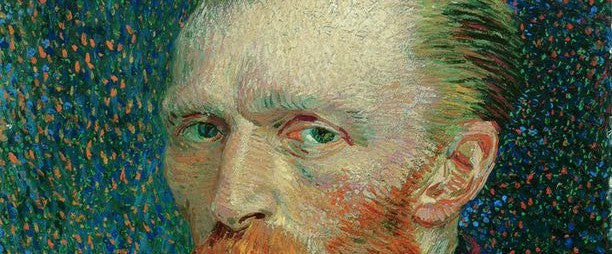
A Self-Portrait in the Paris of the Impressionists
Alice PettirossoShare
Van Gogh's Self-Portrait of 1887 is an emblematic work of the period he spent in Paris, between 1886 and 1888, when the artist was in close contact with the masters of Impressionism and Neo-Impressionism such as Monet, Degas and Seurat. This chapter of his life was a decisive crossroads in his artistic evolution: Van Gogh began to experiment with bold chromatic techniques and abandoned the dark tones of his Dutch period in favor of a brighter and more lively palette. In the Self-Portrait of 1887, the artist is in full experimentation, immersed in research but not yet burdened by the profound torment that would mark his later works, such as those created during his stay in Arles.
The structure of the portrait
In the 1887 work, Van Gogh presents himself in three-quarters, with a solidly delineated bust and a gaze that is hypnotic in its intensity. The essentiality of the composition, with the artist's face standing out against a neutral background, creates a powerful contrast that immediately captures the observer's gaze. Although the painting maintains a classical structure, the energy of the brush strokes and the chromatic vivacity make his self-portrait fresh and modern, distinguishing it from the much more conventional ones of the time.
Color and Brushstrokes: Van Gogh's Technique
The canvas comes to life thanks to the vigorous oil technique, with thick and almost sculptural brushstrokes that infuse the painting with extraordinary dynamism. Van Gogh applies color with courage and spontaneity: the cold tones of the background, dominated by shades of blue and green, contrast with the warm vivacity of the face. His bold and rough use of color testifies to the influence of the Impressionists, but the unique style that distinguishes Van Gogh is already palpable, characterized by a disruptive emotional power and an almost material approach to painting.
A self-portrait between introspection and experiment
Although the primary reason for his numerous self-portraits (there are 35!) is probably the artist's financial constraints - he used himself as a model, for lack of anything else - for Van Gogh, the self-portrait was not just a technical exercise but an intimate exploration of himself. Through his paintings, in addition to refining his style and keeping himself in shape, he explored his psyche. The self-portrait of 1887 is an example of a moment of relative inner quiet: the artist reflects on himself in depth, but at the same time enthusiastically assimilates Parisian influences by experimenting with new chromatic solutions. The self-portraits are an open window into Van Gogh's soul and artistic evolution, and offer the public a rare glimpse into his creative and inner growth.

PRE-ORDER A COPY FOR YOUR HOME
Self-Portrait for Van Gogh Before and After the Torment
Compared to the Self-Portrait with Bandaged Ear of 1889, painted after the famous accident, the 1887 portrait conveys a very different feeling: here we see an artist in search of new ways of expressing himself, and not a man consumed by grief. Even in later works, such as Vincent's Bedroom in Arles , we find the same love of color and light, the cornerstones of his stylistic path. The 1887 self-portrait marks a turning point: the influence of lively Paris and contact with the Impressionist movement shaped a new Van Gogh, who would soon go beyond Impressionism to create his own revolutionary style.
